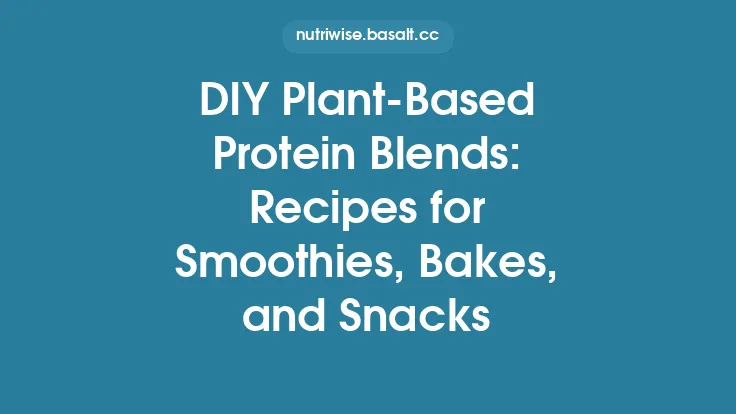When it comes to creating baked treats that satisfy a sweet tooth while still delivering nutritional value, fruit purees and unsweetened applesauce have earned a place of honor in the modern pantry. These ingredients bring natural sugars, moisture, and a host of vitamins and minerals to the table, allowing bakers to reduce added refined sugar without sacrificing flavor or texture. By understanding how these fruit‑based products work, you can confidently swap them into muffins, quick breads, cookies, and even cakes, achieving a balanced sweetness that feels indulgent yet remains health‑conscious.
Understanding Fruit Purees: Composition and Benefits
Fruit purees are simply whole fruit that has been blended or processed into a smooth, spreadable consistency. Depending on the fruit, the puree may contain:
| Component | Typical Range in Purees | Functional Role in Baking |
|---|---|---|
| Natural sugars (fructose, glucose) | 8–15 g per 100 g | Provides sweetness and contributes to browning via Maillard reactions |
| Water | 70–85 % | Supplies moisture, influencing crumb softness and shelf life |
| Pectin & soluble fiber | 0.5–2 % | Acts as a natural thickener and stabilizer, helping to bind batter |
| Organic acids (malic, citric) | 0.2–1 % | Adds subtle tang, balances sweetness, and can affect leavening |
| Micronutrients (vitamin C, potassium, antioxidants) | Varies by fruit | Enhances the nutritional profile of the final product |
Because the puree retains the fruit’s skin and pulp (unless strained), it also contributes a modest amount of insoluble fiber, which can improve the perceived mouthfeel and modestly increase satiety. The high water content means that purees can replace both fat and liquid components in a recipe, but the exact substitution ratio depends on the desired outcome.
Unsweetened Applesauce: A Versatile Baking Companion
Applesauce, when made without added sugar, is essentially a puree of apples that has been cooked down to a smooth, slightly thick consistency. Its popularity in baking stems from several practical attributes:
- Mild, Sweet Flavor – Apples naturally contain fructose and glucose, delivering a gentle sweetness that blends well with a wide range of baked goods.
- Consistent Moisture Level – Commercial unsweetened applesauce typically contains about 80 % water, making it a reliable substitute for liquids.
- Natural Pectin – The pectin in apples helps stabilize batter, reducing the need for additional binders in some recipes.
- Nutrient Boost – A single cup of unsweetened applesauce provides roughly 100 % of the daily value for vitamin C and a good dose of potassium.
Because of its neutral flavor profile, applesauce can be used in both sweet and mildly savory applications, from banana‑apple muffins to spiced carrot loaves.
Balancing Sweetness: How Fruit Purees Contribute Natural Sugars
When swapping out refined sugar, it’s essential to recognize that fruit purees do not provide the same level of sweetness per gram. For example:
- Granulated sugar: ~4 g of sweetness per gram.
- Pureed mango: ~0.6 g of sweetness per gram.
- Unsweetened applesauce: ~0.5 g of sweetness per gram.
To achieve a comparable sweetness level, you may need to increase the amount of puree or combine it with a small amount of a more concentrated natural sweetener (e.g., a drizzle of honey or maple syrup). However, the goal is often to reduce overall sugar rather than replicate the exact sweetness of the original recipe. A practical rule of thumb is:
- Replace 1 cup of sugar with 1 cup of fruit puree and reduce the total liquid in the recipe by ¼ cup to compensate for the extra moisture.
This approach yields a product that is noticeably less sweet but still satisfying, while delivering the fruit’s inherent flavors.
Nutritional Advantages of Fruit‑Based Sweeteners
Beyond the obvious reduction in added sugars, fruit purees and applesauce bring several health‑promoting components to baked goods:
- Antioxidants – Many fruits (berries, cherries, apricots) are rich in anthocyanins and polyphenols, which can help combat oxidative stress.
- Vitamins & Minerals – Vitamin C, vitamin A (from carrots or pumpkin puree), and potassium are common in fruit‑based ingredients.
- Lower Glycemic Impact – The fiber and water in purees slow glucose absorption, resulting in a more moderate blood‑sugar response compared with refined sugar.
- Reduced Caloric Density – While fruit sugars still contribute calories, the overall energy per serving often drops because the bulk of the puree is water.
These benefits make fruit‑sweetened baked goods a smarter choice for those looking to support overall wellness without abandoning the pleasure of a treat.
Practical Guidelines for Substituting Fruit Purees in Recipes
- Start with a 1:1 Replacement for Sugar
Use the same volume of puree as the sugar called for. Adjust later based on taste and texture.
- Modify the Liquid Ratio
For every cup of puree added, reduce other liquids (milk, water, juice) by ¼ cup to keep batter consistency in check.
- Consider the Fruit’s Flavor Profile
Choose a puree that complements the other ingredients:
- Banana for banana‑bread or chocolate muffins.
- Pear for delicate cakes or spice‑laden loaves.
- Berry for tarts, scones, or breakfast bars.
- Account for Acidity
Highly acidic purees (e.g., pineapple, kiwi) can affect leavening. If using a very acidic fruit, add a pinch of baking soda to neutralize excess acid and maintain rise.
- Adjust Leavening When Needed
The added moisture can sometimes slow the rise of quick breads. Increase baking powder by ¼ tsp per cup of puree for a more reliable lift.
- Blend Thoroughly
Ensure the puree is fully incorporated to avoid pockets of excess moisture that could create soggy spots.
Adjusting Texture and Structure When Using Fruit Purees
Fruit purees influence crumb structure in three primary ways:
- Moisture Retention – The high water content keeps baked goods softer for longer, which is ideal for muffins and quick breads but may be undesirable for crisp cookies.
- Binding – Pectin and soluble fiber act as natural binders, reducing the need for eggs in some recipes. However, the binding strength is weaker than that of gluten, so recipes that rely heavily on structure (e.g., delicate pastries) may need a supplemental binder such as a small amount of xanthan gum or a nut‑based flour.
- Crumb Tenderness – The fat‑replacing quality of purees leads to a finer, more tender crumb. For recipes where a chewy texture is prized (e.g., oatmeal cookies), you may want to limit puree to ½ the sugar amount and retain some butter or oil.
When experimenting, keep a baking journal to note the exact ratios, bake times, and outcomes. Small adjustments—like a 10 % increase in flour or a brief extra minute in the oven—can make a noticeable difference.
Flavor Pairings and Enhancing the Fruit Profile
Even though fruit purees bring their own taste, strategic pairings can elevate the final product:
| Fruit Puree | Complementary Ingredients | Suggested Add‑Ins |
|---|---|---|
| Banana | Cinnamon, nutmeg, chocolate chips | Chopped walnuts, dark chocolate |
| Apple (applesauce) | Vanilla, caramel, ginger | Crushed oats, toasted pecans |
| Pumpkin | Maple syrup, pumpkin spice, cream cheese | Toasted pumpkin seeds |
| Berry (strawberry, raspberry) | Lemon zest, almond extract | White chocolate chips |
| Mango | Coconut, lime, chili powder (for a twist) | Shredded coconut, toasted macadamia nuts |
Balancing the natural sweetness with a hint of acidity (lemon juice, orange zest) or spice (cinnamon, cardamom) can prevent the final product from tasting overly sweet and adds depth.
Storage, Shelf Life, and Food Safety Considerations
- Refrigerated Purees – Once opened, store fruit purees and applesauce in airtight containers in the fridge. Use within 7–10 days for optimal flavor and safety.
- Freezing – Purees freeze well. Portion into freezer‑safe bags or containers, label with the date, and use within 3 months. Thaw in the refrigerator before incorporating into batter.
- Commercial vs. Homemade – Store‑bought purees often contain preservatives that extend shelf life but may add unwanted sodium or sugar. Homemade versions give you full control over ingredients but require stricter handling.
- pH Monitoring – Highly acidic purees can lower the overall pH of the batter, which may affect yeast activity in breads. For yeast‑based recipes, keep the total acidity below pH 4.5 to avoid inhibiting fermentation.
Common Pitfalls and Troubleshooting Tips
| Issue | Likely Cause | Solution |
|---|---|---|
| Dense, gummy crumb | Too much puree, insufficient flour | Reduce puree by ¼ cup, increase flour by 2 Tbsp |
| Over‑browning | High natural sugar content + Maillard reaction | Lower oven temperature by 25 °F, add a thin foil tent halfway through baking |
| Soggy bottom | Excess moisture from puree | Increase baking time by 5–10 min, or add a tablespoon of cornstarch to the dry mix |
| Lack of rise | Moisture diluting leavening power | Add ¼ tsp extra baking powder per cup of puree, or increase egg count slightly |
| Off‑flavor | Fruit puree past its prime or contains added spices | Use fresh puree, taste before adding, and adjust seasoning accordingly |
Sample Recipes and Applications
1. Apple‑Cinnamon Muffins (Unsweetened Applesauce Substitute)
- Dry: 2 cups whole‑wheat flour, 1 tsp baking powder, ½ tsp baking soda, 1 tsp cinnamon, pinch salt.
- Wet: 1 cup unsweetened applesauce, ½ cup plain Greek yogurt, 2 large eggs, ¼ cup honey (optional), 1 tsp vanilla.
- Method: Combine dry ingredients, whisk wet ingredients separately, then fold together until just mixed. Bake at 350 °F for 18–20 min.
*Result:* Moist crumb, natural sweetness from apples, reduced added sugar, and a boost of protein from the yogurt.*
2. Banana‑Blueberry Quick Bread (Banana Puree)
- Dry: 2 ½ cups all‑purpose flour, 1 tsp baking soda, ½ tsp salt.
- Wet: 1 cup mashed ripe bananas (≈½ cup puree), ½ cup plain kefir, ¼ cup melted coconut oil, 2 large eggs, ¼ cup maple syrup (optional).
- Add‑In: 1 cup fresh blueberries tossed in 1 Tbsp flour.
- Method: Mix dry and wet separately, combine, fold in berries, bake at 375 °F for 45 min.
*Result:* Sweetness from bananas, tender crumb, and antioxidant‑rich blueberries.*
3. Mango‑Lime Coconut Cookies (Mango Puree)
- Dry: 1 ½ cups oat flour, ½ tsp baking powder, pinch salt.
- Wet: ½ cup mango puree, ¼ cup coconut oil, 1 Tbsp lime zest, 2 Tbsp honey (optional).
- Method: Mix all ingredients, scoop onto parchment, flatten slightly, bake at 325 °F for 12 min.
*Result:* Light tropical flavor, chewy texture, and a modest sweetness from mango.*
These examples illustrate how fruit purees can replace a portion of refined sugar while also contributing moisture, flavor, and nutrients. Feel free to experiment with different fruit combinations, adjusting the liquid and leavening as needed to suit your personal taste and dietary goals.
By mastering the characteristics of fruit purees and unsweetened applesauce, you gain a powerful toolkit for creating baked goods that are both delicious and nutritionally smarter. The key lies in balancing the natural sugars they provide with the overall sweetness you desire, while respecting the moisture and binding effects they introduce. With thoughtful substitution, careful adjustments, and a willingness to experiment, you can enjoy treats that satisfy cravings and support a healthier lifestyle—one spoonful of fruit‑sweetened batter at a time.





